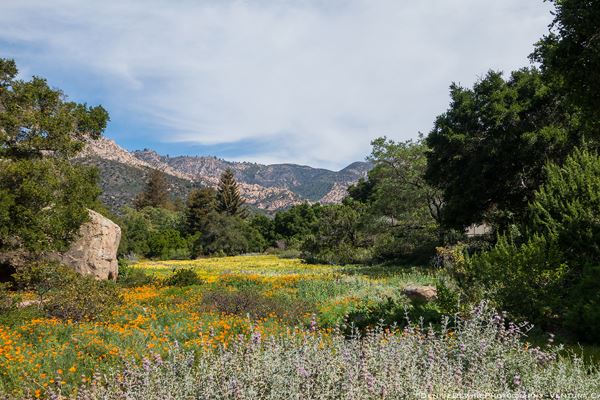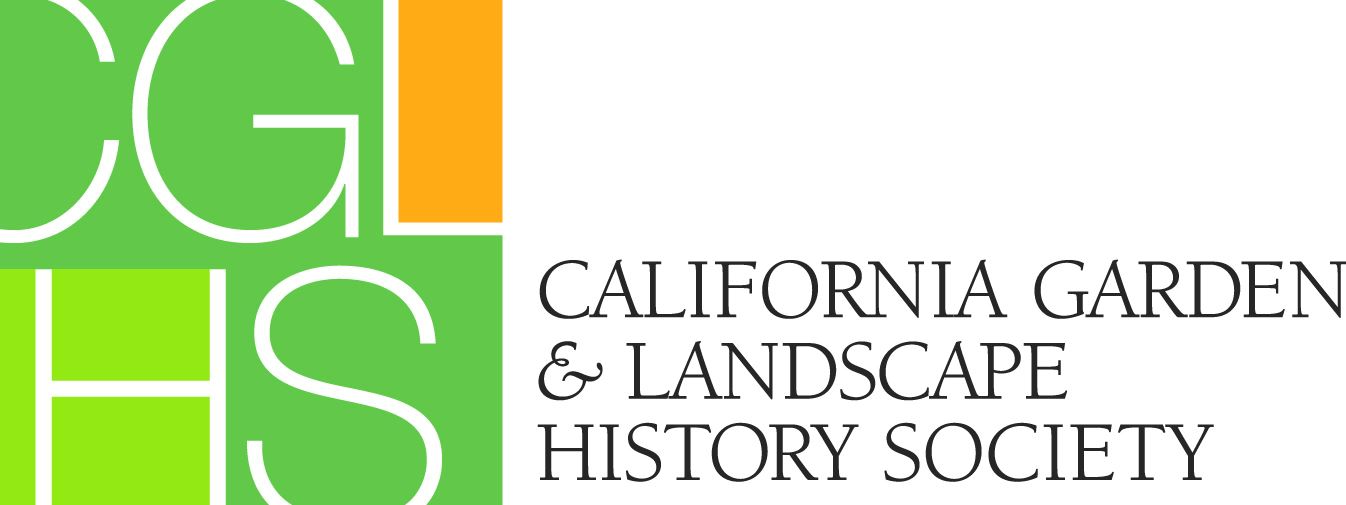Thea Gurns
Until 1995, I was a person happy in my spot; indeed, a person who believed her spot was just the best, no question. I viewed San Diego the way that famous New Yorker cover viewed the world—mapped in detail for several blocks, then perspective narrowed and shortened until the illustration took a quick dive off an edge.

The far southwestern corner of the Golden State held everything for me—coast, flat lands, “back country,” mountains, desert. Beach cliffs, tide pools, coastal sage, streams, lakes. I thought San Diego lacked for little.
When Bill Grant founded the California Garden and Landscape History Society, I went along for the ride. Soon I was hearing names unknown to me—McLarens, father and son; Farrand; Yoch. Who were these people? What had they done? Gardens were mentioned—Bancroft, Saratoga, Val Verde. Where were they? What did they contain?
I began learning from the first meeting I attended, in November 1996, Botanic Heritage Gems of San Diego. Lucy Warren arranged a visit to archived wonders tucked in the basement of the San Diego History Center. Then we gathered in one of Balboa Park’s “secret” meeting places not often open to the public. When we went around the room to name interests, the answers intimidated: botanist, landscape designer, garden researcher, horticultural librarian, historian. “I want to look at pretty places,” I said.
Over the following fifteen years traveling the state to CGLHS conferences. I have looked aplenty at pretty places. Come travel along.
1999 Artistic Legacies
Unlocking the Treasures Behind the Garden Gates
All about the ranchos, Los Alamitos and Los Cerritos, still here in fiercely urban/suburban Long Beach. David Streatfield gave a talk in a newly restored barn where some of us were seated on prickly hay bales. Once home, I immediately went to his book, California Gardens: Creating a New Eden, and learned more.
2000 Garden History of the Monterey Peninsula
I remember walking through whitewashed adobes, their thick walls holding silence. From the preservationist herself, I scored a Frances Grate geranium. It still flourishes in our garden.
2001 Garden History of Sonoma County
Ah, this was the time the historian Tom Brown threw back his head and proclaimed, “There were no mission gardens.” Since then, I never have looked at those misleading things, mission courtyards, in the same way Here we enjoyed a great dinner of locally sourced sausages and vegetables plucked fresh from a plot up the street and drank the esteemed local wines.
2002 Cultivating CapistranoHistoric Valley Gardens and Landscapes
Those assembled enjoyed the happiness of wandering adobe-lined Rios Street at dusk, a magic hour that called forth days now vanished. The mood continued through dinner in Carol MacElwee’s original adobe—thank you, Virginia Gardner!—as we listened to songs of early Californios. Gary Lyon treated us to an impromptu tour of the historic O’Neill ranch, showing us a coastal sage vista that stretched forever and an extraordinary cactus garden he’d planted to surround the house.
2003 Earthly Paradise = Garden History of the San Francisco Peninsula
At the Cantor Center for the Arts we admired Betsy Fryberger’s exhibition on the evolution of garden art that was every bit as fascinating as she had promised. On this, my first visit to Stanford, you could see the way the school grew out of the family estate. Rudolph Ulrich’s Victorian Arizona Garden was a highlight. Former Filoli Director Lucy Tolmach toured us through the Gentleman’s Fruit Orchard there, and we also visited that Craftsman triumph Green Gables. The view of the Santa Cruz hills bewitched.
2004 The Empire that Citrus Built - Landscape History of Old San Bernardino County.
We wandered over the Mission Inn’s crenellations and enjoyed taste-testing at the UC Citrus Research Station, guided by soon-to-retire Tootie. My friend Beki was so taken by citrus she discovered here that she has now propagated 500 to 600 lime varieties and is well on her way to a commercial 1,000. At Fairmont Park we learned dilapidation teaches, too.
2005 Beyond Vineyards - Landscapes of the Napa Valley
Sandra Price sat us down in the St. Helena School auditorium and speakers related how before the grapes, a variety of crops were farmed in the valley. We toured six private gardens set among ubiquitous vineyards. A late afternoon wine reception at historic Spottswoode estate deepened the spell of this famed part of the state. As I’m claustrophobic, I held back as you all descended into Schramsberg wine caves, but I still learned enough to prefer Schramsberg Brut Rose with buttered popcorn.
2006 California’s Saratoga Springs, Orchards and Gardens
Tucked away in hill country, Saratoga revealed itself as a fine retreat for those seeking restoration in the spring waters of a resort town. In the picturesque historic village we met in Old Fireman’s Social Hall, then toured estate gardens, including the impressive Villa Montalvo, and Japanese-style gardens. At Hakone Garden’s moon-viewing pavilion, we participated in the ritual of Japanese tea—an exceptional treat.
2007 California Japanese-Style Gardens Tradition and Practice
Because of this conference, I now drive modest postwar suburban streets hoping to spot remnants of Japanese-style pruning. The lectures were intense forays into American manifestations of Japanese garden styles: estate, teahouse, bungalow, and friendship. We learned about the gardeners who created and maintained them. My friend Nancy Carol Carter used her lunchtime wisely: She darted into an old hardware store and came out with a Japanese grass sickle she uses to slice through thick succulent leaves. As we ate dinner on the garden terrace of the New Otani Hotel, we listened as mystery writer Naomi Hinahara read from her latest novel.
2008 Spirit of Landscape - California’s Lower Owens River Valley
The conference celebrated the beauty and diversity of California’s Eastern Sierra landscape, and few of us there will forget this dramatic mountain, desert, and river valley region, and especially the gardens created by Japanese Americans interned at Manzanar during World War II. Each time we turn on a spigot in these drought-conscious times we’ll remember the changes wrought on the land by the diversion of water from the Owens River into Los Angeles aqueducts.
2010 Santa Cruz - Land of 1001 Wonders
For me, this conference was dominated by our honoree and founder Bill Grant who orchestrated activities in boom-voice fashion. UC Santa Cruz is renowned for its native plant collection. From those around at the creation, we heard how its wonders came to be and over the years evolved. The UC Santa Cruz Arboretum has a plant store, where I picked up the ‘William Grant’ rose, which is named for Bill.
2010 Keeping Up with the Joneses - Beatrix Farrand’s Southern California Gardens
Garden historian Judith Tankard discussed Farrand with an emphasis on her little-known work in SoCal, including the director’s house at the Huntington (where her husband was library director), and at the Santa Barbara Botanical Garden. Then our own Ann Scheid showed us around the Farrand-designed portions of Caltech and Occidental College. The lagniappe for me was a stop at Hale Solar Observatory, a Spanish Colonial Revival gem of reinforced concrete with chimney, mission tiles, rough plastered walls, and deeply set windows. Given National Historic Register status, it is now owned and maintained by the architect couple who saved and beautifully restored it.
2011 Ranchos to Castles - A Tour of San Luis Obispo County
We traveled by bus down the coast past beach towns and up through a valley of farms and vineyards. Dining in the dramatic setting of a hilltop vineyard, we were entertained by historian Victoria Kastner’s illustrated talk about Hearst Ranch. For me the defining moment was realizing at the Dana Adobe that to preserve the original viewscape is as important as saving the house and garden and that an historic vista can be equally worthy of national registration and preservation.
2012 Plants, Passion, and Propagation - A Horticultural Tour of Sonoma County
For me, the high point came on a sweltering day as we sat in the Quarry Hills greenhouse enthralled by tales told by a plant hunter who travels to discover seeds and brings them back to the lab for propagation. Again, our backseat filled with plants, this time from the impressive native plant nursery, California Floral.
2013 A Fresno Frolic
Third-generation inhabitant Bob Boro’s passion shone as he showed us around the Fig Garden area and entertained us in his own Tower District home. I especially remember strolling in Kearney Park under a tunnel of century-old olive trees, imagining how it would feel to ride through the allée in a horse-drawn carriage. The Clark Center of Japanese Art and Culture in Hanford, now closed forever, impressed with its Torii gates, stroll garden, and fabled art collection.
2013 Becoming Public - Design, History, Plants and Preservation in East Bay Gardens
The draw for me was the Ruth Bancroft Garden. What an avid gardener and record-keeper! What she created was exceptional in her time, and with its many water-conserving plants is especially relevant today. At 105 years of age and from her wheelchair, Bancroft was still planting up pots to be sold to help maintain the property. Richard Turner showed us around as he recounted the story of his discovering the garden and how the non-profit Garden Conservancy sprang from a need to preserve this horticultural treasure.
2014 Santa Barbara and The Landscape Legacy of Lockwood De Forest
As we hurried to the opening lecture on our first evening, moist night air carried the scent of coastal sage scrub characteristic of this landscape. With hills hugging close to the sea, Santa Barbara is plein air in real time. All the de Forests knew the magic intimately and showed its gentle beauty and strength on canvas and on the land. Sidney Baumgarten inherited the de Forest “Buffalo” roadster and had it on special display in her driveway. The walk through her house to get to the back garden jolted me. I remember reading 1980s’ design magazines showcasing her work, and now I realize how much my décor is stamped with her influence.
As I read through this list of conferences and tours-and-talks, memories tumble, ideas emerge. Was it at Sonoma that the Luther Burbank house garden grew or was that Jack London’s house I remember? The evening reception in a WPA-built clubhouse: Was that in Monterey or somewhere outside San Luis Obispo? Enlightenment came on journeys to and from sites—vivid orange poppy fields on the way to Lompoc, golden September hills around Walnut Creek, surfers wave-riding Mussel Shoals’ white water.
And then there are all those CGLHS folks who took me in hand and taught me—Marlea Graham, Laurie Hannah, Margaret Mori, Susan Chamberlin, Glenda Jones, Judy Horton: thank you! The backseat plants expand our garden in diversity, a match for my expanding knowledge of the state’s diversity. When a news item names a city or section of California, that name resonates because I can recall where that place is, what it looks like now, and a little bit of times past.
What does my California now feel like? Enlarged. Enriched. My part of California is still the nest, but now other parts—your part—look pretty fine, too. Through these conferences, as a group, we’ve stitched together patches of my, your, our California into one big state garden and landscape quilt.
We still answer David C. Streatfield’s call to arms at our first conference. California’s gardens and landscapes are worth our passion and celebration. This year in San Diego!
Thea Gurns maintains she is a charter member of CGLHS, as it’s not her fault the application was lost in the mail and she missed the 1995 organizational meeting!




